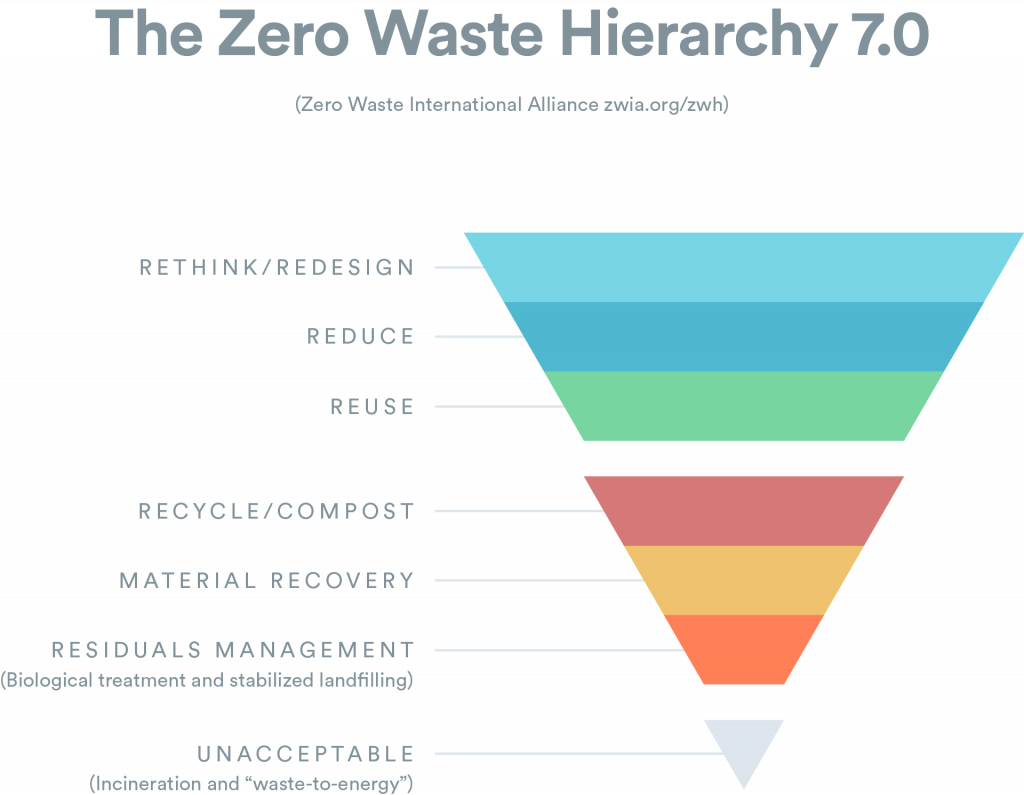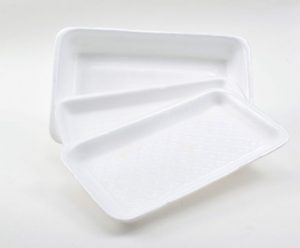For anyone interested in recycling and waste reduction, whether it’s at home or for your business, it’s likely that you’ve come across the concept of a waste management hierarchy before. As part of a move towards more sustainable economies and waste disposal systems, these frameworks are incorporated into plans, programs, and regulations around the world, with the goal of guiding all sections of society in the decisions and actions they take on a daily basis.
The zero-waste hierarchy is much the same, and in fact, has been developed from earlier versions used within the 3 R’s system. However, it has deviated and expanded significantly from those frameworks of the past and is continually developing as new challenges arise. But what is the zero-waste hierarchy exactly? And how can the framework be used to guide everyone’s efforts to reduce waste and keep materials in circulation as long as possible? Here we take a look at today’s most widely accepted definition of the concept.
What is the Zero Waste Hierarchy?
At its core, the zero-waste hierarchy sets out a list of strategies and actions designed to support the wider zero-waste system. Taking the familiar pyramidal shape common to most hierarchical diagrams, it builds on the 3 R’s system to create a list of priorities from best to worst use of materials.
Many variations of this waste management hierarchy exist, and prominent zero waste lifestyle proponent, Bea Johnson, also has her own version: Refuse, Reduce, Reuse, Recycle, Rot. However, when it comes to the last word in zero-waste thinking, the Zero Waste International Alliance (ZWIA) offers the most comprehensive and in-depth approach to the zero-waste hierarchy.
The ZWIA Zero Waste Hierarchy
The Zero Waste International Alliance is the only internationally peer reviewed zero-waste hierarchy in the world, and as a result, is the most comprehensive and inclusive, as well as the most regularly updated, adapting to new challenges, technologies, materials, and products as they enter the market. Based on a 7 R’s principle, the pyramid is currently in its seventh iteration and it is in constant development.

Rethink and redesign
Rethinking and redesigning products and materials to encourage more circular production and consumption is always the first and most preferable choice on the zero-waste pyramid. This means identifying our most wasteful practices and reimagining ways to reduce their impact. Whether it’s the extraction of raw materials or the way in which we recycle, the idea is to ensure we are constantly developing new and more efficient ways to work towards zero waste.

- Using recycled or sustainably harvested natural resources within products. Renewable, non-toxic, materials that are both durable and repairable, reusable, or fully recyclable must also be prioritized
- Incentivize the Circular Economy, cyclical materials. Disincentivize wasteful products and processes.
- Promote sharing economies and services over “ownership”
- Promote EPR (extended producer responsibility). Producers take back products and packaging in line with the zero-waste hierarchy.
- Phase out materials that are problematic within closed loop systems.
- Support local markets and local economies and discourage needless consumption.
Reduce
Reducing our waste wherever possible is the next step on the zero-waste pyramid, with a focus on redefining the concept of waste to ensure more materials and products are kept within the loop for as long as possible. Additionally, examining our priorities and shifting resources for increased efficiency and sustainability also falls under this section of the zero-waste hierarchy.

- Minimize spoilage using better planning systems for perishables and compostable items.
- Minimize use of toxic materials
- Reduce the ecological footprint of products and services
- Promote products and materials that can be easily, cheaply, and continuously recycled.
- Prioritize the use of edible food for humans (and animal feedstock)
- Eliminate disposable product options wherever possible and instead switch to reusable options
Reuse
Reusing, maintaining, repairing, and retaining value wherever possible is the next best possible use for materials and products. Maximizing reuse is the overarching goal, and at both production and consumer levels, there are a variety of ways in which this can be achieved. Additionally, as some elements within this section of the zero-waste hierarchy develop, it is thought that “reuse” will become even more prevalent.

- Promote reuse of materials and products wherever possible.
- Retain value for products through maintenance, repair, and refurbishment.
- Reuse disassembled components to remanufacture “new” products. Store and repair components for repair of products in use.
- Reuse unrepairable products in new and alternative ways.
Recycle/compost
There remains huge potential within the recycling and composting sectors to deal with waste efficiently, however, it should never be treated as the go-to solution over and above more efficient usage of materials and products. Priorities within this stage of the zero-waste hierarchy include recycling without loss of quality, while also decentralizing composting facilities and promoting sustainable natural cycles.

- Develop systems to ensure materials are kept within their product loop while also preserving the usefulness of materials
- Develop diversion systems that support efficient recycling systems. Always consider the highest and best use for all materials.
- Collect, distribute, and recycle as locally as possible
- Expand both individual and municipal composting programs/facilities, including anaerobic digestion systems.
Materials recovery
Promoting more efficient material recovery and energy recovery through better separation of mixed materials at the source, and the recovery of materials from already existing discard sites (such as landfill or e waste faciltities) are two core factors within this section. Additionally, energy recovery from materials should only be performed through natural systems that require no energy input and that operate at biological temperatures and pressures.

- Maximize material recovery through comprehensive separation of waste streams at the source. Increase education and information to ensure source separation is simple on both consumer and production levels.
- Only use energy recovery and waste-to-energy systems that work with natural processes without the introduction of more energy.
Residuals management
Residuals management is the term given to “true waste” management, as in, those things that cannot be processed within any of the above systems. In essence, it begins the loop again by asking how we can rethink, reduce, reuse, and recycle to further minimize products and materials reaching this stage of the zero-waste hierarchy. Additionally, it looks at how we manage this waste and its byproducts to extract the maximum possible benefit from all materials and products.

- Continuously analyze and assess residuals and discarded materials to identify how they can be eliminated in line with the zero-waste hierarchy.
- Stabilize fermentable materials through biological stabilization to reduce emissions and leachate among other undesirable impacts.
- Plan infrastructure to adapt to fewer residuals as they are eliminated.
- Responsibly manage existing landfill capacity and eventual size reduction, minimize gas production and release, maximize gas collection
Unacceptable
 The final stage of the zero-waste hierarchy highlights practices and ideas that should be seen as unacceptable in the framework of the zero-waste concept. This includes the incineration of materials and products for energy in particular, while also removing support for any policy or system that encourages or relies upon the production or destruction of discards or recyclables.
The final stage of the zero-waste hierarchy highlights practices and ideas that should be seen as unacceptable in the framework of the zero-waste concept. This includes the incineration of materials and products for energy in particular, while also removing support for any policy or system that encourages or relies upon the production or destruction of discards or recyclables.
- Remove support for policies and systems that incentivize or promote the destruction of materials and products
- Remove support for energy generation systems that are dependent of residuals and discards to recover energy
How useful is the zero waste hierarchy?
As a conceptual framework, the zero-waste hierarchy is highly important, advising leaders and policymakers as to the most efficient use of our resources and how we reduce the environmental, economic, and social damage waste causes. Its usefulness is embodied in its progressive structure and flexible nature; this is not a set of inflexible laws that cannot be broken, but rather a structured collection of guiding principles that can and should be applied wherever possible, with the added bonus of being progressive enough to adapt to change.
As a business or consumer, the zero-waste pyramid is also an extremely useful tool to guide and inform zero waste analysis and identification. This means taking the time to assess our practices and habits, working through each stage of the hierarchy and managing products and materials to ensure they are always fall under “best use”.
How can I use the Zero Waste Hierarchy?
Using the zero-waste hierarchy is a simple as reading and understanding the principles and applying them. Always ask yourself which action is the highest on the zero-waste hierarchy, and match the best case to specific materials, products, processes, habits, or practices either at home or at work. For example, if you can compost at home, you should, and wherever possible you should refuse (or at least reuse) wasteful items, such as single-use plastic bags, packaging, and water bottles.
The challenge today, however, is to begin thinking and implementing waste-free design into more aspects of our daily life, turning the conventional production/consumption paradigm on its head and planning for the entire life cycle of a product or material. For businesses, developing new products and services in line with the zero-waste hierarchy must now be the priority, while for consumers, continuing to demand better solutions while also taking responsibility for individual waste generation must go hand in hand.
For more information, subscribe to zerowaste.com today or chat with one of TRUE Advisors. Alternatively, keep checking back here for the best zero-waste ideas and info!

